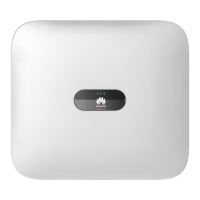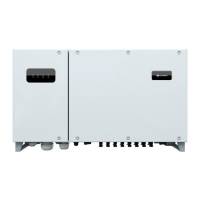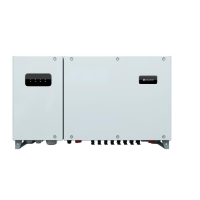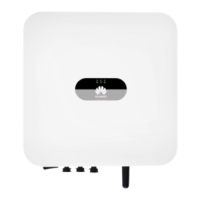● If the Low Insulation Resistance alarm is not reported one minute after the
DC is supplied, the fault occurs on the disconnected PV module and optimizer.
Choose Device Commissioning > Maintenance > Inverter ON/OFF on the
App and send a shutdown command. Go to Step 7.
● If the Low Insulation Resistance alarm is still reported one minute after the
DC is supplied, the fault does not occur on the disconnected PV module or
optimizer. Go to Step 6.
Step 6 Set the DC switch to OFF, reconnect the removed PV module and optimizer, and
repeat Step 5 to check the adjacent PV modules and optimizers.
Step 7 Determine the position of the ground insulation fault.
1. Disconnect the possible faulty PV module from the optimizer.
2. Set the DC switch to OFF.
3. Connect the possible faulty optimizer to the PV string.
4. Set the DC switch to ON. If the solar inverter status is Shutdown: Command,
choose Device Commissioning > Maintenance > Inverter ON/OFF on the
App and send a startup command. Check whether the Low Insulation
Resistance alarm is reported.
– If the Low Insulation Resistance alarm is not reported one minute after
the solar inverter is powered on, the PV module is faulty. Choose Device
Commissioning > Maintenance > Inverter ON/OFF on the App and
send a shutdown command.
– If the Low Insulation Resistance alarm is still reported one minute after
the solar inverter is powered on, the optimizer is faulty.
5. Set the DC switch to OFF. Replace the faulty component to rectify the
insulation resistance fault. Go to Step 2 to check other PV strings. Then go to
Step 8.
Step 8 If the solar inverter connects to batteries, turn on the auxiliary power switch of the
battery and then the battery switch. Set the DC switch to ON. If the solar inverter
status is Shutdown: Command, choose Device Commissioning > Maintenance >
Inverter ON/OFF on the App and send a startup command.
----End
SUN2000-(3KTL-10KTL)-M1 Series
User Manual E Locating Insulation Resistance Faults
Issue 17 (2024-01-12) Copyright © Huawei Technologies Co., Ltd. 130

